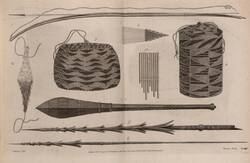Further Media
Producer unknown to us
Oceania, Polynesia, Tonga Archipelago (Tongatapu, 'Eua, Nomuka or Lifuka/Ha'apai group)
Before 1781
Wood – probably club tree (Casuarina equisetifolia)
Acquired in 1773–74 or 1777 on Captain James Cook’s second or third expedition in the Pacific. It is yet unknown by whom the object was acquired.
Brought from Great Britain to Germany by Benjamin La Trobe, a Moravian working in London.
Inv. no. 68390
It were British sailors – Captain Cook and his crew – who gave the “paddle club” its current name in Western museums and on the European art market 250 years ago. In fact, the original Tongan paddles looked different.
The design of Tongan paddle war clubs followed mainly spiritual and genealogical requirements. This is the case with the side of the Herrnhut “paddle war club,” which is actually modeled on the leaf of the Tongan sī plant (Cordyline fruticosa) – a sacred plant with spatula-shaped bright red leaves that was everywhere in the presence of the Tongan high nobility and still lines ceremonial sites and graves throughout Polynesia. Even the sī leaf design of a war club, like the one in the Herrnhut Cook collection, identified the owner as an aristocrat.
The production of the carving was a small challenge for the master carvers (tufunga tātā): The genealogical and spiritual codes of the ancestral gods had to fit perfectly into the sī-leaf-shaped face of the club. Because of their original shape, such “oar clubs” – and clubs in general – were among the South Sea objects most often brought back to Europe by Cook’s crew. This was partly because the shape and carving had special decorative value in the eyes of the British arrivals.
